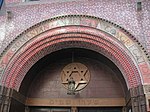Rivington Street station
1880 establishments in New York (state)1942 disestablishments in New York (state)Defunct New York City Subway stations located abovegroundFormer elevated and subway stations in ManhattanIRT Second Avenue Line stations ... and 4 more
Manhattan railway station stubsRailway stations closed in 1942Railway stations in the United States opened in 1880Use mdy dates from January 2017
Rivington Street was a local station on the demolished IRT Second Avenue Line in Manhattan, New York City. It had two levels. The lower level had two tracks and two side platforms while the upper level had one track that served the express trains. The next stop to the north was First Street. The next stop to the south was Grand Street. The station closed on June 13, 1942.
Excerpt from the Wikipedia article Rivington Street station (License: CC BY-SA 3.0, Authors).Rivington Street station
Allen Street, New York Manhattan
Geographical coordinates (GPS) Address Nearby Places Show on map
Geographical coordinates (GPS)
| Latitude | Longitude |
|---|---|
| N 40.720502777778 ° | E -73.989866666667 ° |
Address
Allen Street 145
10002 New York, Manhattan
New York, United States
Open on Google Maps





